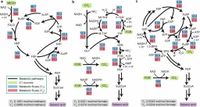Rapid advancements in systems metabolic engineering are transforming how microbial cell factories produce sustainable biochemicals. These state-of-the-art bioprocesses capitalize on various microorganisms to convert renewable resources into valuable chemicals, including fuels and polymers, without relying on finite fossil fuels. At the heart of this innovation is the need for efficient production methods capable of minimizing costs and maximizing yields, a challenge that researchers at KAIST have undertaken.
The study highlights the intricate metabolic capabilities of five key microbial strains—Escherichia coli, Saccharomyces cerevisiae, Bacillus subtilis, Corynebacterium glutamicum, and Pseudomonas putida. Each strain holds unique advantages in converting substrates into over 200 different bio-based chemicals. By investigating the maximum theoretical yield (YT), which reflects the optimal production of target chemicals if all resources were utilized effectively, the researchers are piecing together a comprehensive picture of microbial performances.
As the authors wrote, "The production performance is defined by three key metrics: titer, productivity, and yield." Titer refers to the concentration of the end product, productivity measures the rate of production over time, and yield is the efficiency with which raw materials are converted into products. Yield is particularly critical since it directly influences raw material costs and overall process economics.
To aid in the selection of ideal strains for specific chemical productions, the researchers incorporated genome-scale metabolic models (GEMs). These sophisticated computational models simulate the inner metabolic workings of the microbes and allow scientists to predict how strains will perform under various conditions. The goal is the construction of more efficient metabolic pathways, thereby enhancing the innate capabilities of these microorganisms.
By using GEMs, researchers can not only identify potential genetic targets for modification but also optimize existing biosynthetic pathways. This capability was demonstrated through in silico knockout simulations, which the authors noted can determine gene targets that may enhance chemical production without the need for exhaustive laboratory experiments.
A case study concerning the production of l-lysine—a key amino acid used in animal feed—illustrates these principles in action. Researchers discovered that different strains yield varying amounts of this compound from the same substrates. For instance, in tests utilizing glucose, Saccharomyces cerevisiae produced 0.8571 mol/mol glucose, while Bacillus subtilis and Corynebacterium glutamicum came in at 0.8214 and 0.8098 mol/mol glucose, respectively. These results highlight the importance of not only selecting the right strain but also understanding the metabolic pathways involved in production.
In terms of methodologies, the study emphasizes various metabolic strategies, including the addition of heterologous reactions to expand a strain's capabilities. For example, introducing new reactions into the metabolic network of a cell can often result in improved yields for specific chemicals. The authors wrote, "Metabolic engineering enhances the chemical production abilities of microbial cell factories by optimizing cellular characteristics within their metabolic capacity." Such findings underscore the need for a tailored approach to strain selection, leveraging detailed understanding of microbial metabolism.
The discussion extends into practical applications, particularly regarding the production of more complex chemicals such as sebacic acid, a precursor for nylon, or even larger-scale biofuels. Here, the analysis of varying carbon sources—like methanol and carbon dioxide—reveals how the choice of substrate significantly influences yield outcomes depending on the selected strain and the assimilation pathways employed. This adaptability presents exciting avenues for further research.
Additionally, examining cofactor exchanges—those metabolic helpers critical in biochemical reactions—reveals further potential optimization strategies. Certain metabolic pathways benefit from changing specific cofactors, leading to lower energy costs and higher production efficiency. This aspect of metabolic flux optimization demonstrates just how responsive and complicated these microbial systems can be.
As researchers continue to evaluate these microbial systems, it becomes increasingly clear that optimizing yields and production performance require a nuanced approach. With growing pressure to meet sustainable production goals and the rising demand for bio-based chemicals, the resources provided in this study will be invaluable for future metabolic engineering projects.
While the presented findings do not capture every dynamic aspect of microbial growth, they provide a robust framework on which scientists can build further advancements. As research into systems metabolic engineering evolves, the hope is to streamline the transition from laboratory discoveries to industrial-scale biomanufacturing, paving the way for a more sustainable chemical production landscape. Ultimately, optimizing these microbial cell factories will be critical in contributing to a more circular economy.




